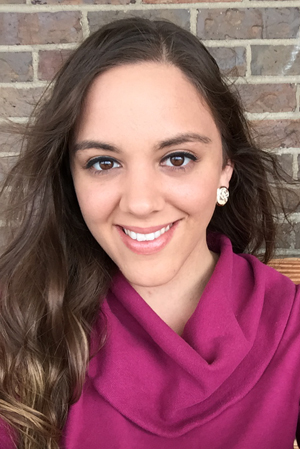After nearly two years in treatment, now 20, feeling much better and realizing she needed to “do something,” Gnyp decided to start over and re-enroll at Volunteer State part time, where she could stay close to home. She no longer had tuition help from her scholarship, but she’d struck a deal with her dad, an orthopedic sales rep who himself had gotten a bachelor’s degree at Wayne State University in Michigan.
“I had an agreement with my father, that he would help me with my tuition payments if I kept my grades at 3.0 or higher, and I would contribute when I could. I worked different part-time jobs throughout college -- I worked at Lowe’s and as a waitress for a couple of years -- sometimes two at once, while going to school.”
 Gnyp said she’s grateful to have emerged on the other side with no student loans, even though getting through the two-year associate program took nearly four years, first as a part-time pre-nursing major for two years, then switching to a full-time medical lab technology major, which took a year to complete.
Gnyp said she’s grateful to have emerged on the other side with no student loans, even though getting through the two-year associate program took nearly four years, first as a part-time pre-nursing major for two years, then switching to a full-time medical lab technology major, which took a year to complete.
While her particular case may be unique, Gnyp's path to higher education is more typical of an American college student than what is often portrayed in the media: the recent high school graduate showing up on a leafy college campus away from home for a four-year college experience. According to the American Association of Community Colleges, community college students make up 45 percent, or nearly half, of all U.S. undergraduates; 7.3 million students are enrolled in both full- and part-time two-year associate and certificate programs.
Community college students also encompass a more diverse group than four-year institutions: 36 percent of community college students are the first in their families to go to college, and nearly 30 percent are parents themselves; black, Latino and minority students make up half the student population, and nearly all students work at an outside job while attending school.
Yet Gnyp is a financial outlier, since she had financial help from her parents: 60 percent of students receive some kind of financial aid to attend community college, whether through federal loans and grants, help from the school or work study, to help meet the average yearly tuition of $3,400 (as compared to the average four-year college, which is $9,400). Since most community college students come from low-income backgrounds, many struggle to juggle multiple responsibilities, work and stay in school long enough to graduate.
“There’s a high percentage of first-generation college students, a high percentage of folks that are working full time and going to school part time,” said Karin Weaver, executive director of development at Nashville State Community College in Nashville, Tennessee. “And so they are really saying, ‘I’ve got to get my bills paid and my family fed, but at the same time I’m trying to figure out a way to get into a better job.’”
One of Weaver’s main responsibilities at Nashville State is to try to meet the financial gap between grants, loans and scholarships and what students can afford. Unlike many four-year colleges, this work can be difficult. Because many community college graduates don’t make high-level salaries after entering the workforce, many colleges struggle with small endowments, and often rely on the community and local employers for financial gifts. Weaver said that she’s always looking at how to design programs to engage donors that might interest them.
“The fundraising piece is really huge,” she said. “When you think traditional higher ed, you’ve got alumni associations, endowments -- but a lot of our alum are just average folks making average wages. Some of them are coming out and going into high-level positions, but as a whole, the students we serve are low-income folks."
Therefore, Weaver said, even with federal aid, it’s critical to keep financial gifts coming in to serve what she sees as community colleges’ vital longtime mission: helping catapult students into the middle class.
A Short History of Community Colleges
The first “junior college” was founded in 1901 in Joliet, Illinois, as a two-year liberal arts institution for students who wanted to stay close to home and then eventually finish their last two years at a four-year university. It was only after the Great Depression that community colleges began offering more job training and vocational programs similar to those being offered in Europe, especially Germany.
But it was the GI Bill, along with the Truman Commission calling for more Americans to have access to higher education, that changed everything: By the 1960s, a massive expansion of local colleges spread across the country to serve individual communities’ needs, both to expand who could go to college and to train skilled workers for better jobs. It was during the '60s that nearly 500 of today’s more than 1,100 community colleges were created.
And while vocational education -- like heating and air-conditioning certificates or engine repair -- continues to be the domain of community colleges, American Association of Community Colleges' data show that more 2014 graduates got their associates degrees in liberal arts and sciences (33 percent) than in any other field, even health care. More data from 2014 show 60 percent of community college graduates went on to earn their bachelor's in four years or less, and 12 percent more were persisting toward graduating after four years.
From Access to Completion
Tom Bailey, who serves as director of the Community College Research Center at Columbia University, said that another shift occurred for community colleges around the 21st century mark, when the focus shifted from providing access to helping students achieve completion.
“Where we were thinking of community colleges as access institutions -- which of course, they did a good job, they’re cheap, they’re ubiquitous, you can work, you can go part time,” Bailey said. “But then I would say in the early 2000s, was the beginning of what is now called the ‘completion agenda.’ ”
In the year 2000, the Department of Education began publishing graduation rates for every community college, and even taking into account the very narrow criteria used to gather the numbers (including counting all transfers, even to four-year schools, as a dropout), the numbers were dramatically low, hovering around the 20 percent mark.
“People realized that community colleges had a concentration of the types of students we’re all worked about, right? Low-income students, minority students, first-generation immigrant, all of those. People whose jobs went away because of foreign competition or technological change, and they’re coming back to get retrained, all of those were things for community college. So there was much more attention paid to them.”
Research showed that students who attained any sort of degree would dramatically increase lifetime earnings over a high school diploma, so community colleges began to concentrate on not just getting students to college, but helping them stay until they finished.
The completion agenda has sparked such initiatives as guided pathways and Obama’s America’s College Promise, which is based on the very successful Tennessee Promise program, all in support of a national push to increase community college completion by 50 percent by the year 2020.
After a long and often winding six-year process in and out of school, Anastasia Gnyp graduated on May 17, 2016, with her associate's degree as a medical lab technician -- a career path she’d heard about from a family friend and found, once she investigated, that she loved. Volunteer State had recently build a new medical division, where she said everything seemed “advanced and high tech.” Vol State offers a bridge program to local Austin Peay State University, After establishing herself in her new career in a couple of years, Gnyp is planning to earn her bachelor’s degree there.
Even though staying in school, working and managing her illness was often tough, Gnyp wanted to share her story to encourage others to keep going.



 Gnyp said she’s grateful to have emerged on the other side with no student loans, even though getting through the two-year associate program took nearly four years, first as a part-time pre-nursing major for two years, then switching to a full-time medical lab technology major, which took a year to complete.
Gnyp said she’s grateful to have emerged on the other side with no student loans, even though getting through the two-year associate program took nearly four years, first as a part-time pre-nursing major for two years, then switching to a full-time medical lab technology major, which took a year to complete.